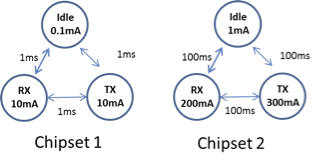
Wireless Networking aka “Wireless for IoT Class”
Course code: CS4222/CS5422
Semester 2, 2022/2023
Instructor: Professor Ambuj Varshney
Contact: ambujv@nus.edu.sg, COM3: #02-25
TUTORIAL 4 for WEEK 6 (Starting 13th of February 2023)
[1] Question 1: What is the typical battery capacity of common devices that you use in your daily life such as wearables (Apple Watch/Fitbit), earphones, laptops, and mobile phones?
[2] Question 2:
-
In the figure represnting state transition diagram, which chipset is more suitable for used in Internet of Things applications? Explain your reasoning.
-
For the chipset chosen in the question above, assume that the devices are designed to operate at a very low duty-cycle (<0.01%) and you are allowed to reduce the current drawn from only one of the states (idle, receive (RX) or transmit (TX)). Which state would you reduce the current from?

[3] Question 3: Please find specification of following technologies:
| Specification | Bluetooth | ZigBee | WiFi | LoRa | LoRea (Backscatter) | Judo (Backscatter) |
|---|---|---|---|---|---|---|
| VDD(V) | 1.8 | 3.0 | 3.3 | 3.3 | 2 | 0.12 |
| Transmit (mA) | 60 | 30 | 220 | 28 | 0.035 | 0.7 |
| Receive (mA) | 50 | 25 | 210 | 13.8 | N.A | N.A |
| Bitrate (Mb/s) | 1.2 | 0.25 | 54 | 0.027 | 0.003 | 0.1 |
- Calculate the energy (in milli-joules (mJ)) require to transmit 1 bit for different technologies listed above.
- For low power IoT devices, should you always select the network technology with the lower transmission energy per bit? Explain your answer
- In addition to energy needed to transmit/receive a bit, what other criteria(s) should you take into account when selecting a network technology for use in a low power Internet of Things?
- What kind of applications would choose to use Bluetooth technology?
- What kind of application would choose to use LoRa technology?
- What kind of application would choose to use Backscatter technology?